Clash of Titans
Games featuring a future Hall of Fame coach on each sideline.
November 10, 1928: Army vs Notre Dame
Biff Jones vs Knute Rockne
Coming into the 1928 season, Knute Rockne was worried about his team.
"My second (string) team of last year, with one exception, will be my first team this year. Practically every team we played in 1927 scored on the second team in a minute and a half. Indiana scored on it in fifty seconds. Toward the end of the season the boys were showing some improvement because it took one team two minutes to score. Having greater responsibilities this year, however, these boys may do much better."
A series of injuries further depleted the '28 Irish, who lost two of their first six games. Rockne's critics were wondering if he'd lost his touch, and his magic was gone.
Army entered what had become its annual clash with Notre Dame with a better record than the Fighting Irish. Biff Jones's third Cadet team was 6-0 while Knute Rockne's 11th squad at his alma mater had lost road games at Wisconsin and Georgia Tech. Notre Dame was concerned about finishing with a losing record since they still had games with powerful Carnegie Tech and Southern California on its schedule.
Each coach was an alumnus of the school he coached. Jones was a 1917 graduate of West Point, where he played tackle on the varsity and was elected captain his senior year. After serving as an artillery lieutenant in World War I, he became an assistant coach at his alma mater under both Charlie Daly and John McEwan.
"Win One for the Gipper"
The day before the Army game, Rockne told a half-dozen football writers about his philosophy of coaching.
I don't think a college football team can be brought to the top of its emotional pitch more than twice in a season of nine or ten games. If there are two games you've got to win, you can point for those, especially if one is the last game on the schedule. But you've got to try to take the others in stride.
Rockne had apparently decided that the next day's game against Army would be one of the "two games you've got to win" for 1928.
Featured Player
The star of the 1928 Army team was 23-year-old halfback Keener "Red" Cagle. He had played four years at Southwestern Louisiana Institute in Lafayette where he scored 235 points from touchdowns, extra points, and field goals. That record lasted until 1989.
The native of Merryville LA also starred in basketball and track and field at SLI.
When Cagle completed his four years of eligibility after the 1925 season, his coach concocted a plan that would enable his star to play four more years of college football. He arranged with a Louisiana congressman to secure Cagle a presidential appointment to the United States Military Academy.
Cagle started in the Army backfield from game one, helping the Cadets to a 7-1-1 record in Coach Jones's first season in 1926 and 9-1 in 1927 when he made the consensus All-American team.Six years out of high school and in love with a young lady |
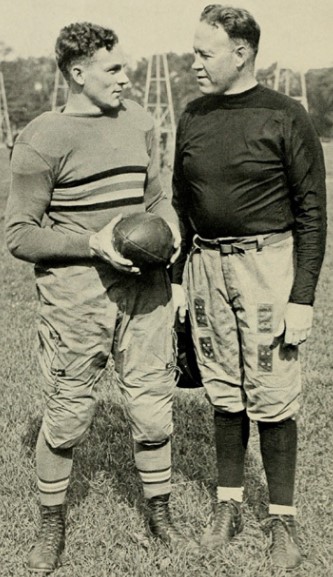 Red Cagle and Coach Biff Jones (USMA Howitzer Yearbook Class of 1929) |
| back home in Louisiana, Cagle decided not to return to West Point for the 1928-29 school year. So he married his sweetheart, keeping it secret from even their families until he could notify the West Point authorities in person, which would lead to his expulsion from the Academy. But when he returned to West Point, his teammates talked him into playing another season. | |
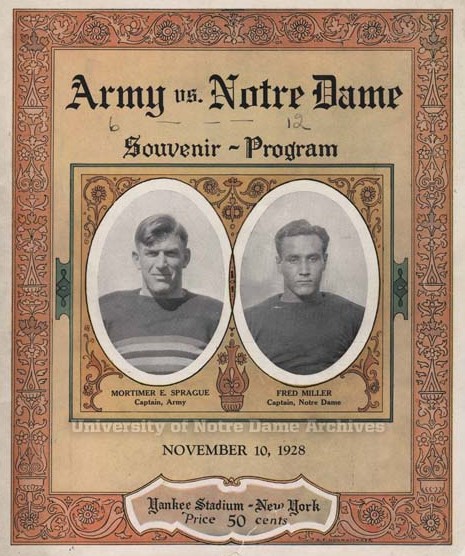
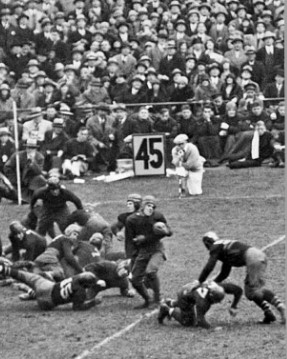
L: Game Program; R: Jack Chevigny carries the ball for Notre Dame.
Before a crowd estimated at 80,000 in Yankee Stadium, Notre Dame was inspired, but so was Army. The best the Fighting Irish could do was hold the Cadets to a scoreless tie at the half.
The Irish frittered away an excellent opportunity to score early in the second quarter, which began with Johnny Niemec punting out of bounds on Army's two. The Cadets immediately kicked out of danger to their 38.
Fred Collins ran through left tackle for a first down on the 16, where he was tackled by Cagle. Collins carried twice more to the 11 and then the five. After Jack Chevigny got a yard at center, Collins fumbled as he was going over the goal line, and Cadet John Murrell recovered for a touchback to put the ball on the 20.
Neither team threatened the rest of the first half.
Rockne Gives Inspiring Halftime Speech
During halftime, Rockne gathered his two-touchdown underdog team in their dank locker room in Yankee Stadium and delivered the most famous halftime speech in football history.
George Gipp was an All-American halfback and Notre Dame's leading rusher and passer for three straight seasons starting in 1918. During his senior year, when he was 25 years old, Gipp died of complications from strep throat.
Rockne was at Gipp's bedside during his final days. Speaking softly and emotionally, he told his 1928 team about a final request that Gipp had made.
"You know, boys, just before he died, George Gipp called me over close to him and in phrases that were barely whispers, he said, 'Sometime, Rock, when the team's up against it, when things are wrong and the breaks are beating the boys—tell them to go in there and win just one for the Gipper. I don't know where I'll be then, Rock, but I'll know about it, and I'll be happy.' Within a few minutes that great Notre Dame gentleman, George Gibb, had died."
Rockne continued, "Boys, I'm firmly convinced that this is that game George Gipp would want us to win for him. Okay, let's go!"
Line coach Ed Haley recalled, "There was no one in the room that wasn't crying. There was a moment of silence, and then all of a sudden those players ran out of the dressing room and almost tore the hinges off the door. They were all ready to kill someone."
Army Finally Scores
Taking the second half kickoff, Notre Dame, behind a line that was whipped into a frenzy, drove 80y until Fred Collins, playing with his broken wrist in a cast, fumbled on the two.
After two plays, Army was suddenly deep into Irish territory. The drive started with Cagle's 20y run followed by his long pass to Edwin Messinger to the Notre Dame 13. Niemiec saved a touchdown with a diving tackle. But that only delayed the inevitable. Three plays later, Army faced fourth and a half yard for a first down. Cagle hit the center of the line for a short gain. A measurement made it first-and-goal at the three.
The Irish almost made a goal-line stand as Cagle carried twice for just a yard. An offside penalty on the defense moved the ball a half-yard from the goal. Finally, John Murrell smashed into the end zone. The extra point attempt failed. Army 6 Notre Dame 0
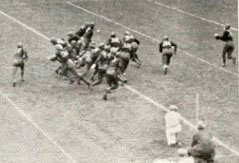
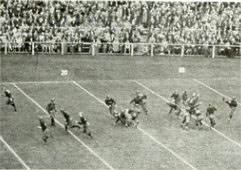
L: Cagle back to pass for Army; R: John Murrell punts for Army
(US Military Academy Howitzer Yearbook Class of 1929)
Notre Dame Ties the Score
Later in the period, Notre Dame drove 46y to tie the score. First, 5'7" 170lb HB Jack Chevigny called the Irish into a huddle and reminded them of their obligation to win. He shouted, "We've got to score before the end of the period!" The biggest gain came on Fred Collins' 19y on an end around to the 24. Three plays later, Chevigny, the "Hammond (IN) Flash," dove over tacklers for a first down at the 12 where Cagle stopped him. Three more runs made it fourth down and a half yard to go for a first down. Collins got it on the two.
Army continued to give ground grudgingly. The Cadets threw Collins for a 2y loss, but he gained back the yardage on the next play. Then his 1y gain made it fourth and a half yard to go for the touchdown. Chevigny cut to his left and drove a would-be tackler into the end zone to tie the score. After he scored, Jack got off the ground and shouted, "That's one for 'The Gipper!'"
But Notre Dame also missed the extra point to keep the score tied at six.
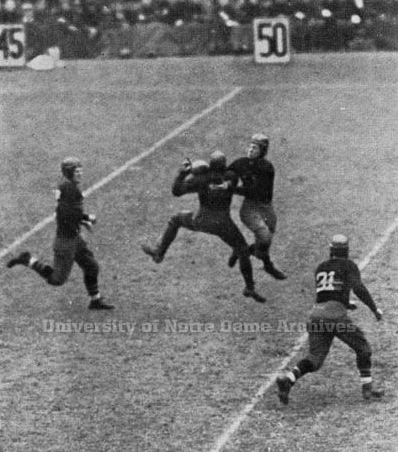
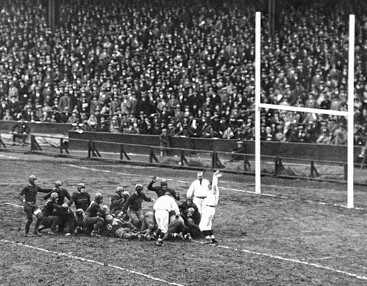
L: Chris Cagle intercepts Notre Dame pass. R: Chevigny scores to tie the game.
Desperation Pass Scores Winning Touchdown
The tense standoff continued deep into the fourth quarter. Notre Dame received a punt on its 42 and started a march into Army territory.
Two runs gave the Notre Dame a first down on Army's 47. Chevigny, on a double reverse, ran to the 30. After faking a pass, Chevigny made a first down on the 16. Then disaster struck. A bad pass from center rolled back to the 33 where Chevigny sacrificed his body to recover the loose ball. Pinned beneath multiple Cadets, he suffered a concussion and had to be carried off the field.
Rockne replaced Chevigny with Bill Drew while 6'4" Johnny O'Brien, a hurdler on the track team, threw his blanket aside and replaced Johnny Colrick at left end. It was his first appearance on the field that afternoon. O'Brien was an exceptional pass receiver but otherwise lacked the physical qualifications Rockne demanded of a regular end.
Facing second and 25, Frank Carrideo threw two straight incompletions. That set up the winning touchdown play.
Niemiec arched a wobbly pass toward O'Brien, who had gone downfield and veered toward the right sideline. He stretched to get his hands on the ball at the 15, juggled it as it hit his shoulder pad and then his chest, and gained possession at the 10. He raced past two defenders, stumbled, and dove into the end zone out in the right field sector of Yankee Stadium that Babe Ruth patrolled in the summer. The sensational pass and catch put Notre Dame ahead 12-6 with less than two minutes to play.
Watching from the sideline, Chevigny yelled, "That's one for 'The Gipper' too."
When O'Brien got up, he saw Rockne beckoning him to the sideline, where the coach threw a blanket over his receiver and grabbed his hand and shook it vigorously. The rarely used end would forever be known as "One Play O'Brien."
Future West Point head coach Earl "Red" Blaik was an assistant coach for the 1928 team. He wrote a decade later: "It is possible that if we had defended with a zone, O'Brien would have continued to be known as just plain Johnny. On the other hand, he might still have become 'One Play.' The point is, O'Brien taught us painfully that, henceforth, we should use a zone."
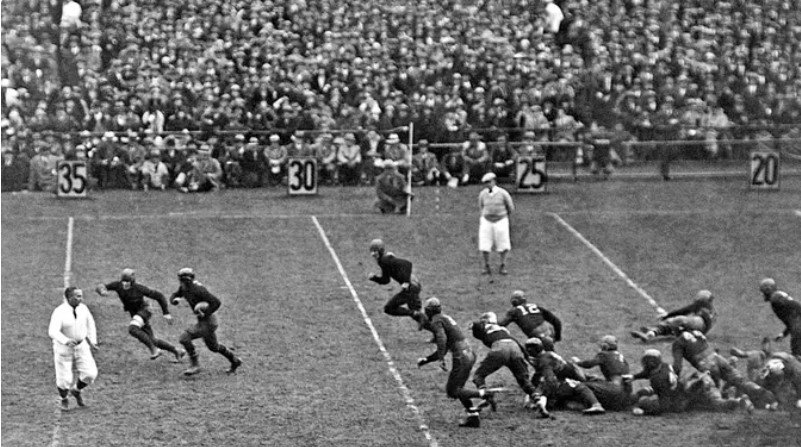
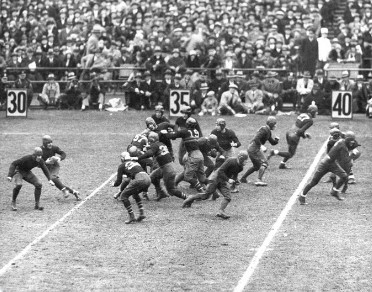
L: Jack Chevigny gains 25y. R: John Niemiec back to pass for Notre Dame.
Army wasn't about to roll over and play dead. Cagle took the ensuing kickoff on his 25 and "ran through the whole Irish team" in the gathering dusk before Collins, the last man who had a shot at him, made a diving tackle on the Notre Dame 30.
Fighting exhaustion, Cagle threw an incompletion, then swirled around end for a first down on the 10. After Army was penalized 5y for delaying the game, Cagle misfired on another pass. Richard Hutchinson replaced Cagle and threw an incompletion, which in that era earned a 5y penalty. Undaunted, Hutchinson connected with Herbert Gibner to put the ball back on the 10. But the final whistle sounded taps for Army before they could run another play.
FINAL SCORE: NOTRE DAME 12 ARMY 6
The West Point yearbook for 1928-29 started its report of the game like this:
But one second more, oh for a second, was the cry which rose from the Corps as the game ended with the ball on Notre Dame's half-yard line [actually the 10] and the score 12-6 in favor of the Irish. The feature of the game was Cagle's 55-yard run from kickoff in the last minute of play. For a moment it looked as though he would score, but they finally brought him down on the 20-yard line [actually the 30].
Sunday night, 5,000 people gathered at the Notre Dame gymnasium to welcome the triumphant Irish back home.
The 1928 Fighting Irish would finish their season with a 5-4 record, Rockne's worst in 13 seasons as head coach. The four losses were 1/3 of his 12 total losses. Yet on that one afternoon in Yankee Stadium, they pulled the upset.
References
Notre Dame Football Review - 1928
Rockne: Idol of American Football, Robert Harron (1931)
You Have to Pay the Price, Earl H. Blaik with Tim Cohane (1960)
Shake Down the Thunder! The Official Biography of Notre Dame’s Frank Leahy, Wells Trombly (1974)
Notre Dame 1990 Football Press Guide
College Football’s Most Memorable Games, 1913 Through 1990: The Stories of 54 History-Making Contests, Fred Eisenhammer and Eric B. Sondheimer (1992)
100 Things Notre Dame Fans Should Know & Do Before They Die (Kindle), John Heisler, Bryant Young, and Frank Stams (2013)
Notre Dame Football Review - 1928
Rockne: Idol of American Football, Robert Harron (1931)
You Have to Pay the Price, Earl H. Blaik with Tim Cohane (1960)
Shake Down the Thunder! The Official Biography of Notre Dame’s Frank Leahy, Wells Trombly (1974)
Notre Dame 1990 Football Press Guide
College Football’s Most Memorable Games, 1913 Through 1990: The Stories of 54 History-Making Contests, Fred Eisenhammer and Eric B. Sondheimer (1992)
100 Things Notre Dame Fans Should Know & Do Before They Die (Kindle), John Heisler, Bryant Young, and Frank Stams (2013)